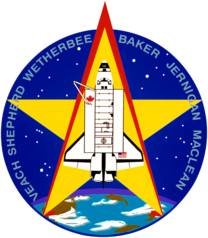STS-52
| Missionsemblem | |||||
|---|---|---|---|---|---|
 | |||||
| Missionsstatistik | |||||
| Missionsnavn: | STS-50 | ||||
| Rumagentur: | NASA | ||||
| Rumfartøjets navn: | Columbia (13) | ||||
| Antal besætningsmedlemmer: | 7 | ||||
| Affyringsrampe: | 39A KSC | ||||
| Opsendelse: | 22. oktober 1992 | ||||
| Landing: | 1. november 1992 | ||||
| Landet på: | KSC | ||||
| Varighed: | 9 dage | ||||
| Foto af besætningen | |||||
 | |||||
| Navigation | |||||
| |||||
STS-52 var Columbias 13. rumfærge-mission. Opsendt 22. oktober 1992 og vendte tilbage den 1. november 1992.
Besætning

 James Wetherbee (kaptajn)
James Wetherbee (kaptajn)
 Michael Baker (pilot)
Michael Baker (pilot)
 Charles Veach (1. missionsspecialist)
Charles Veach (1. missionsspecialist)
 William Shepherd (2. missionsspecialist)
William Shepherd (2. missionsspecialist)
 Tamara Jernigan (3. missionsspecialist)
Tamara Jernigan (3. missionsspecialist)
 Steven MacLean (nyttelastspecialist)
Steven MacLean (nyttelastspecialist)
Missionen
Hovedartikler:
Eksterne henvisninger
- STS-52 NASA (engelsk)
| ||||||||
Medier brugt på denne side
Flag of Canada introduced in 1965, using Pantone colors. This design replaced the Canadian Red Ensign design.
Five NASA astronauts and one Canadian payload specialist composed the STS-52 crew. Pictured on the back row, left to right, are Michael A. Baker, pilot; James B. Wetherbee, commander; and Steven G. Maclean, payload specialist. On the front row, left to right, are mission specialists Charles (Lacy) Veach, Tamara Jernigan, and William Shepherd. Launched aboard the Space Shuttle Columbia on October 22, 1992 at 1:09:39 p.m. (EDT), the crew's primary objectives were the deployment of the Laser Geodynamic Satellite (LAGEOS II) and operation of the U.S. Microgravity Payload-1 (USMP-1).
Forfatter/Opretter: By Rei-artur (diskussion · bidrag)., Licens: CC-BY-SA-3.0
Venus/female symbol.
STS-52 Columbia, Orbiter Vehicle (OV) 102, crew insignia (logo), the Official insignia of the NASA STS-52 mission, features a large gold star to symbolize the crew's mission on the frontiers of space. A gold star is often used to symbolize the frontier period of the American West. The red star in the shape of the Greek letter lambda represents both the laser measurements to be taken from the Laser Geodynamic Satellite (LAGEOS II) and the Lambda Point Experiment, which is part of the United States Microgravity Payload (USMP-1). The LAGEOS II is a joint Italian \ United States (U.S.) satellite project intended to further our understanding of global plate tectonics. The USMP-1 is a microgravity facility which has French and U.S. experiments designed to test the theory of cooperative phase transitions and to study the solid\liquid interface of a metallic alloy in the low gravity environment. The remote manipulator system (RMS) arm and maple leaf are emblematic of the Canadian payload specialist Steven MacLean.
The Space Shuttle Columbia is launched from Pad 39B on a ten-day mission with a crew of five NASA Astronauts and a Canadian Payload Specialist. The Photograph was taken by astronaut Steven R. Nagel from a Shuttle Training Aircraft. Mission STS-52 payloads onboard include the Laser Geodynamic Satellite II.
This scene represents the end of NASA's STS-1 mission and the beginning of STS-2 in that the orbiter Columbia is arriving at Kennedy Space Center in Florida to begin the lengthy process of preparing it for STS-2. The vehicle landed at Dryden Flight Research Center on April 14 after an historic 2 1/3 day flight in Earth orbit. It was mated to this 747 aircraft, titled NASA 905, and flown over the USA to its Florida destination. It was later removed from atop NASA 905 and moved to the orbiter processing facility for the beginning of refurbishment.
Forfatter/Opretter: Rei-artur (diskussion · bidrag), reshaped by F l a n k e r (talk), Licens: CC-BY-SA-3.0
symbol of Mars. 400 × 400 pixels nominal dimensions, line 45 pixel tick, circle 295 × 295 pixel, not joined with arrow. Colour: red=0 green=0 blue=140.
![]() Vektorgrafikken blev lavet med Inkscape.
Vektorgrafikken blev lavet med Inkscape.











